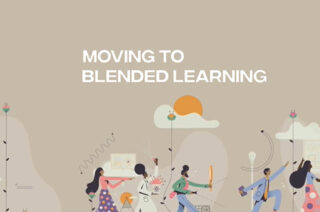Synchronous session planning as part of Blended Learning

Dr Andrew Weightman and Dr James Brooks introduce these resources on synchronous session planning
:
View the transcript (.docx, 18KB).
[Note: This video, captions and transcript were created using tools available to teaching staff: MS Teams and the Video Portal.]
General tips
- Share the main teaching aims/outcomes of the session with students at the start
- Summarise and link asynchronous material to the synchronous session
- Include active learning (see below for examples)
- Use as an opportunity to support wellbeing (especially by enabling students to connect with others, give time/help to others, and take notice of others around them)
- Change activity roughly every 10-minutes to reset student attention spans
Nick Weise’s 6-minute video goes into more detail about how to engage students in synchronous sessions.
Examples of synchronous sessions
Your teaching could be here! Please email the FSE Teaching Academy if you would like to share a summary or case study for a session that goes particularly well, whether that’s due to interactivity with the students, or using technology in an interesting way.
Many thanks to the colleagues named below for their examples of on-campus or online synchronous sessions – with a focus on active learning – that have worked well. We share their examples in their own words, and have included links to further information on the tools used in the summaries so you can run similar sessions with your students. Support is also available for the set up and delivery of online and blended teaching and learning.
Simon Raw’s Presentation Skills Tutorial: an online session plan
Plan for an online tutorial for 20-30 students to introduce presentation skills.
Technology: PowerPoint; YouTube; Zoom with chat and breakout rooms.
Andrea Schalk’s workshop session ideas
Timed 2-hour structure for a workshop format synchronous session that introduces a new topic and where students solve problems in small groups and provide peer feedback in larger groups. Connect the workshop content to assessed work for the topic.
Technology: No specific tools needed.
Martin Simmons’ Introductory Session: 2nd Year Materials (Introduction to Corrosion)
Timed 45-minute structure for introducing a new topic. Includes: Interactive discussion of core concepts; poll to check understanding; sign-posting future content/activities; question and answer session to finish.
Technology: Blackboard; Kahoot; PowerPoint; TurningPoint; Zoom.
Elika Aminian’s international online lecture during lockdown
Timed structure for 1.5 hour live online sessions combining reviews, interactive elements (quizzes and students sharing outputs) and short lectures.
Technology: Mentimeter.
Nick Weise’s flipped learning: online or on-campus
Nick’s three videos (10-22mins) demonstrate how he uses the flipped approach to teach common biochemical reactions both online and on-campus. The first video is his instructional video which students watch in advance, the second and third show his synchronous sessions with students – one on-campus session from 2019 and the other an online session in 2020.
Technology: Overhead Projector & pencil; YouTube; Zoom with chat and breakout rooms.
Martin Simmons’ online group work: 2nd Year Structures (Unit Load Method)
Timed 45-minute structure for students working on questions in small groups online, supported by GTAs and finishing with whole group feedback and poll to check understanding.
Technology: Blackboard, Kahoot; PowerPoint; Zoom.
Andrea Schalk’s ideas for activities in synchronous sessions
Four different activities to use as appropriate to vary your approach to synchronous sessions depending on where you are in the wider course unit / related to assessments.
Technology: TurningPoint.
Andrea Schalk’s ideas for sessions based on student questions
Timed 1-hour structure for a synchronous session based on student questions submitted at least 24 hours in advance, supported by two staff members.
Technology: Blackboard; Interactive Whiteboard; Zoom.
Bernard Treves Brown’s problems classes using Padlet: online or on-campus
Re-usable, timed plan for live online sessions (of 1 hour 50 minutes including a 10-minute break). Bernard’s plan includes pre-session prep, welcome, gathering ideas and comments on previous exercises, a 45-minute workshop exercise, review and panel discussion with Graduate Teaching Assistants (GTAs), and his observations on what makes for more successful sessions (spoiler: content rather than structure).
Technology: Padlet.
Louise Walker’s Tutorials and computer labs
Louise covers:
- suggested activities that allow the students to actively do mathematics, with support and feedback from teaching staff
- explanation of how to use scaffolding to support progress and identify specific points of difficulty
- timed examples of structures
- recording (parts of) tutorials
Technology: Kahoot; Mentimeter; TurningPoint; Quizziz*; or a quiz that just involves students putting their hands (real or virtual) up.
Louise Walker’s Review Sessions
How to support the students in their learning (after they have completed appropriate asynchronous learning activities).
Technology: Zoom with chat.
Aurelie Le-Normand’s summary of feedback from Fashion Business Technology academics
Technology: Chat; Googledocs; Google Slides; Google Forms; Jamboard; Kahoot; Mentimeter; Padlet; Quizziz*; Rubrics in Blackboard; Tablet; Visualiser; Zoom with polls.
*Quizziz is not supported by the University / Faculty at this time; as with any non-supported tool, you are welcome to to use it as long as you do your own due diligence (e.g. for GDPR compliance) and self-support in using the tool.
Simon Raw’s Presentation Skills Tutorial: an online session plan – Foundation Studies
(delivered as a tutorial session to 20-30 Foundation Year students students on Zoom)
1. Aims of the session
Show the students the main teaching aims/outcomes of the session on PowerPoint (I think it’s important that students are aware of the main focus of the session and how it fits into the wider course/their wider learning, and in particular how it links to assignments).
e.g. Main teaching aims/outcomes:
- to discuss and practise presentation techniques
- to introduce signposting language and presentation frameworks
- to highlight strengths and weaknesses in example presentations
2. “Warm up” activity
Show students YouTube clip to highlight pitfalls of PowerPoint presentations (whole class). Ask students to take notes on any points of interest etc.
3. Discussion in Zoom Breakout Rooms (groups of 5-6 students)
One student nominated to take notes and be “spokesperson” for the breakout room group when back in main room. Groups asked to reflect on previous experiences of giving presentations, maybe at school/college etc. what went well/not so well.
4. Feedback to whole class back in main room
Each spokesperson asked to summarise main points from discussion/main reflections – to whole class.
5. Ways of starting a Presentations – capturing your audience’s attention right at the start
Tutor elicits ways of engaging the audience when starting a presentation – to whole class. (Answers can be written in chat or verbal. Tutor can write a summary list of responses. )
Tutor shows some widely-used ways of opening a presentation and interacting with/connecting with the audience on PowerPoint – compare this to the list from the elicitation above.
- Share an interesting fact/surprising statistic (make sure it’s relevant)
- Tell a (short) relevant anecdote
- Ask the audience a question – answer the question yourself
- Quote somebody famous (must be relevant to your topic)
- Refer to a relevant discovery / piece of research
- Or just tell the audience what your topic is and briefly explain why you chose it
6. Mini Presentations – to build confidence in speaking to others about a familiar topic
Students work individually on preparing a short presentation about a familiar topic e.g home town, favourite food, hobby, special talent etc. Think about how to engage the audience at the beginning.
In breakout rooms (different groups) students deliver these short presentations. Other group members can ask questions/encouraged to interact. Tutor can visit breakout rooms to ask questions/offer feedback etc.
Andrea Schalk’s workshop session ideas – Computer Science
Some units used a workshop format. Here’s an example for a unit that used fortnightly two hour workshops to introduce a new topic:
- 10 minutes: Intro to session and topic.
- 20 minutes: Students try to solve Problem 1 in small groups. GTAs circulate among groups to ensure groups are on task and to help with queries about the task.
- 10 minutes: bring whole group together and encourage individuals to talk about their solution, or problems they ran into.
- 20 minutes: Students try to solve Problem 2 in small groups.
- 10 minutes: bring whole group together and get individuals to talk about their group’s approach, and to compare Problem 2 with Problem 1.
- 20 minutes: Students go into groups again, but now two groups from the previous two group activities form one bigger group. The groups look at each other’s solutions and are encouraged to constructively criticise the other group’s solution.
- 20 minutes: Bring whole group together and try to extract good ideas or weaknesses of approaches. Lecturing staff ask questions to ensure specific ideas are mentioned, might provide high level summary.
- 10 minutes: Explain how workshop relates to assessed piece of work connected with topic.
Martin Simmons’ Introductory Session: 2nd Year Materials (Introduction to Corrosion) – MACE
- Introduce topic with slide showing news headlines referring to events which emphasise important of corrosion (5 minutes)
- Brief description of fundamentals of corrosion, show some examples at UoM (5 minutes)
- Cover series of concepts using PowerPoint slides and regular multiple choice questions which students respond to using TurningPoint software. Recap and elaborate on concepts as necessary. (25 minutes)
- Review learning outcomes using Zoom poll/Kahoot quiz (5 minutes)
- Inform students of what will be taught next and signpost to activities on Blackboard (5 minutes)
- Question and Answer session for any remaining time
Elika Aminian ’s international online lecture during lockdown – MACE
Cohort Context: all MSc, Majority international students, about half connecting from China, during lockdown.
Some asynchronous materials were upload in Blackboard in advance (in total equivalent to 1.5h out of 3 hours of contact time but in various forms. Students were recommended to engage with the material before the class but they were told that IF they cannot make time, they are still expected to attend the sync session and they still benefit from it.)
- The live session starts with a joke on weather (this works really well as half of the students never visit the campus they are going to graduate- sense of community)
- Intro and Review of the learning objectives of the session, and how it is mapped against async and sync content (15 mins).
- Simple one or two anonymous Menimeter quizzes to warm them up. (Ideally the questions have something to do with the async material, but simple enough so those student who had not engaged with the material can contribute) (5mins)
- 15-20 mins lecture. Then a short learning activity (sending comments on Mentimeter or just speaking up). Again 15-20 mins lecture and a longer learning activity (the second learning activity usually requires them to post something to Blackboard discussion or upload to Blackboard later after the class). Again around 15 min lecture
- Q &A. (if Q&A is too quiet, I throw some questions to the class)
Nick Weise’s flipped learning: online or on-campus – Chemistry
Short asynchronous content on 5 common types of biochemical reactions (10:38 mins)
2019 Podcast (13:10 mins) from face-to-face session:
Session timings:
- 5 min: group discussions as people come in about the video
- 35 min: group work with Qs from course alumni (myself / PostDocs circulating)
- 10 min: solutions provided by myself addressing mistakes encountered
2020 Podcast (21:15 mins) from Zoom session:
Session timings:
- 10 min: group work with Qs from course alumni (in breakout rooms)
- 5 min: Zoom poll + solutions provided addressing mistakes encountered
- 10 min: group work with Qs from course alumni (in breakout rooms)
- 5 min: Zoom poll + solutions provided addressing mistakes encountered
- 10 min: group work with Qs from course alumni (in breakout rooms)
- 5 min: Zoom poll + solutions provided addressing mistakes encountered
The questions in the synchronous feedback classes are re-designed each summer by PASS Leaders who took the unit the year before – so this is why they are different in the two podcasts.
Martin Simmons’ online group work: 2nd Year Structures (Unit Load Method) – MACE
- Start with review of previous week’s content, highlighting strengths and weaknesses from Blackboard Multiple choice tests (5 minutes)
- Introduce questions that students work on in small groups. Use a series of multiple choice questions in PowerPoint to get them thinking about how to approach each question (5 minutes)
- Students work on questions in small groups (Zoom breakout rooms), supported by GTAs. Lecturer moves in between groups (20 minutes)
- Feedback from selected groups on the questions, explaining how they solved and difficulties they may have encountered (10 minutes)
- Kahoot Quiz or Zoom poll to check understanding (5 minutes)
- Question and Answer session for any remaining time
Andrea Schalk’s ideas for activities in synchronous sessions – Computer Science
Some units changed their approach to the synchronous session each week depending on where they were with respect to various assessments.
So the unit used the following activities in various mixes:
- Review key ideas from asynchronous material.
- TurningPoint quizzes to support the previous.
- Introduce the coming assessment and allow students to ask questions. (Many students dislike only having this information in written form.)
- Given generic feedback about completed assessment: What did students do well, and where did they lose marks? Provide explanation for why approaches that lost marks are not as wanted.
Andrea Schalk’s ideas for sessions based on student questions – Computer Science
For one of our units the synchronous sessions last year were structured around student questions regarding the material presented asynchronously. Students were encouraged to ask their questions at least 24 hours before the session on Blackboard so that lecturing staff could prepare suitable examples.
The live session was then:
- 30-40 minutes: Go through solving examples live with the students based on queries raised on Blackboard. These were new examples (neither appearing in the notes nor in the videos), and the solving was carried out live and as interactively as possible using the Zoom chat. Where appropriate Blackboard polls (Collaborate) were used to ask students to have a go at answering the question (yes/no) before the problem was solved.
- The final 10-20 minutes were devoted to questions that came up on the spot.
Staff used something like an interactive whiteboard (see below) and created the solution from scratch with the students, which allowed everybody to witness the thought processes that went into the solving.
There were two staff members present in each session so that one could concentrate on solving the problem while the other could keep an eye on the chat to make sure that questions or comments weren’t overlooked.
This unit would like to have suggestions for how one could mimic something like this on campus, since students were much more interactive using a chat function than they were in the past speaking up in lecture theatres.
Suggestion from Teaching Academy: this could be done by using the chat part of a video conferencing tool in the lecture theatre, or by using an interactive whiteboard-type tool such as Jamboard or Padlet. or a dedicated thread within a Discussion tool, such as Piazza.
Bernard Treves Brown’s problems classes using Padlet: online or on-campus – CEAS
If online, in advance:
Prepare a Padlet for every breakout group and create link from a folder on Blackboard which is set to appear at the start of the session (30 min).
- Welcome and very brief summary of the contents of the week’s videos (5 min)
- Go through exercises between videos – in this case ideas/comments left on Padlets (10 min)
- Explain workshop exercise (5 min) E.g. Plan building a bridge – produce a Gantt chart using Post-its/Padlet notes
- Workshop (40 min) – Open breakout rooms/tell in-person groups to get going
Including a 10 min break now at 1 h 10 min.
- Review of Padlets/Wrap up (5 min)
- Panel discussion with GTAs and online chat/questions from the floor – How do we plan research projects? What problems have we had? (35 min)
As far as I can tell, success of sessions like this is largely down to the content rather than the structure. E.g. some of the most successful Y1 sessions were basically problems classes. The interest was using unexpected examples, such as firework fuels, leaving students to work in groups on the calculations, but also to discuss the implications, such as “what makes a good firework fuel?” “Which of the materials you looked at would be best” – and inviting comments on a Jamboard.
The same goes for an engineering ethics lecture – several of Zoom/Kahoot/Mentimeter polls addressing issues:
- Is a one in a million chance of death broadly acceptable?
- Would you spend more per life saved in multiple fatality events than single?
- How much would you spend to save a life (that is, do you agree with the Department of Transport’s numbers?)
Louise Walker’s Tutorials and computer labs – Maths
Tutorials will be where students actively do mathematics, either on their own or in groups, and with support and feedback from a lecturer or GTA. They should not be used just for the lecturer to go through solutions to the exercise sheets. Examples of activities that could be used in a tutorial include:
- Kahoot, TurningPoint, Quizziz*, Mentimeter quiz, or a quiz that just involves students putting their hands (real or virtual) up;
- Students in breakout groups working through scaffolded exercises (see below) that they have not seen before (for example, by tweaking existing exercises or keeping back some exercises from the existing example sheets);
- Students in breakout groups working on other group activities;
- The tutor discussing with the whole group what they have been working on in the session.
Scaffolded Exercises
A scaffolded exercise is where one takes an exercise that is, or could have been, on an exercise sheet and breaks it down into shorter parts. The idea is that weaker-to-average students can make progress on the exercise within the short time-frame of the tutorial, thereby gaining confidence in their abilities; it also helps the lecturer to identify the specific points in the exercise that students find hard. See also the references.
Structure of a tutorial
The structure of a tutorial will vary across different course units (and likely from week to week within a given course unit). A sample tutorial might be:
- quiz (5 mins)
- students work in groups of 5-6 (in breakout rooms if online) on new exercises with the lecturer/GTA going around each group in turn (30 mins)
- the lecturer goes through some of these exercises with the whole group (15 mins)
It’s recommended that the tutorial in Week n covers material taught in Week n-1 or earlier. Tutorials in Week 1 might cover revision or introductory material.
Tutorial recordings
Parts of a tutorial which can be recorded MUST be recorded and made available to students on that course unit. This follows feedback from students in 2020-21, noting concerns about network problems, time-zones, etc, and the fact that we cannot disadvantage students on the remote study option.
As a rule-of-thumb:
- any activity where there is no requirement for a student to interact can be recorded without consent.
- Any activity where the expectation is for students to speak or to be identified needs explicit consent.
- For tutorials organised in the above way, the Kahoot/Quizizz/etc quiz and the tutor going through material can normally be recorded; students working in break-out rooms should not.
- It is always good practice to remind students when the session is being recorded so that those studying remotely can turn their cameras and microphones off if they prefer.
Some rooms equipped with Dual Delivery will have directional microphones that may record on-campus students’ personal conversations during break-out group/individual work activities. You should either pause the recording during these activities or edit it out afterwards to avoid this.
Louise Walker’s Review Sessions – Maths
These classes are not there to deliver new content (that is what the asynchronous material is for); instead they are to support the students in their learning. You should assume that the students have done the asynchronous tasks that you have stated in the weekly learning plan. The review session should not just be repeating the material from the asynchronous videos.
Typical activities in a review session might include:
- Recapping material from the short videos;
- Going through additional examples that were not covered in the asynchronous material;
- Going through the formative short-answer exercises/quizzes that follow the asynchronous material;
- Responding to questions raised by students (by email or via the discussion forums/chat function);
- Explaining common misunderstandings that students often make on the material they have been studying;
- Showing how the material the students have been studying that week fits into the bigger picture of the course unit, how it links to earlier material, or how it will be used later in the course.
There should be some opportunity for student interaction in these sessions, for example for them to ask questions via the chat function. Feedback from students suggests that they much prefer using the chat function in Zoom over asking questions via the audio, but there should still be an opportunity for students to speak if they want to.
Note that on-campus students should have access to the chat function. See the guidance on dual delivery on this.
The structure of the review session will vary across different course units (and probably from week to week within a given course unit). A sample review session might be:
- recap of the main ideas in the short videos (15 mins)
- going through some of the formative short-answer questions (15 mins)
- running through an additional example or proof (10 mins)
- Q&A (10 mins)
Review sessions MUST be recorded and made available to students on that course unit. This is so that students who cannot attend due to illness, caring responsibilities, network problems (if studying remotely), etc, can still access the material. It also satisfies our obligations to make lectures available to DASS-registered students whose DASS statements require access to podcasts.
Aurelie Le-Normand’s summary of feedback from Fashion Business Technology academics – Materials
Aurelie gathered feedback from many academics in her discipline on the following:
- What makes a good ‘live’ session – Structure, Content & Delivery
- What makes a good ‘live’ session – Engagement
- What makes a good ‘live’ session?
- Other hints and tips
- Technology & Software
- Feedback – Formative and Summative
- Challenges for Academics – preparing content for blended learning & delivery
- Challenges – Marking
- Things we need more info on
Download further details: summary as pdf (764 KB) or summary as pptx (126 KB).


